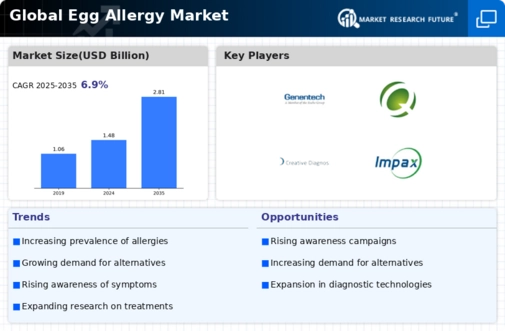Market Analysis
In-depth Analysis of Egg Allergy Market Industry Landscape
The market dynamics of the egg allergy market are influenced by various factors that impact supply, demand, pricing, and overall industry growth. Egg allergy is a common food allergy, especially among children, characterized by adverse reactions to proteins found in eggs. Managing egg allergies requires specialized products and services to ensure the safety and well-being of individuals with this condition. Several key dynamics drive the performance of this market.
One of the primary drivers of the egg allergy market is the increasing prevalence of food allergies, including egg allergies, worldwide. Changes in lifestyle, dietary habits, environmental factors, and genetic predisposition contribute to the rising incidence of food allergies in both children and adults. As awareness of food allergies grows and diagnostic capabilities improve, more individuals are diagnosed with egg allergies, driving demand for allergy testing, allergen-free products, and allergen avoidance strategies.
Technological advancements play a significant role in driving market dynamics in the egg allergy market. Innovations in food processing techniques, ingredient substitutions, and product formulations have led to the development of a wide range of allergen-free food products, including egg substitutes, baked goods, sauces, and prepared meals. Additionally, advancements in diagnostic testing methods, such as skin prick tests and blood tests, enable healthcare providers to accurately diagnose egg allergies and develop personalized treatment plans for patients.
Demographic trends also influence market dynamics in the egg allergy market. Children are more likely to develop egg allergies than adults, with many outgrowing the allergy as they age. However, a significant number of individuals continue to experience egg allergies into adulthood, requiring ongoing management and support. As the population grows and diversifies, there is a greater need for allergen-free food options and allergy management resources to accommodate individuals with egg allergies across all age groups and demographics.
Regulatory factors significantly impact market dynamics in the egg allergy market. Stringent regulations govern the labeling, manufacturing, and marketing of food products containing allergens, including eggs. Compliance with regulations such as those set forth by the Food and Drug Administration (FDA) in the United States and the European Food Safety Authority (EFSA) in Europe is essential for companies operating in this market. Manufacturers must ensure that their products are accurately labeled and free from allergens to meet regulatory requirements and ensure consumer safety.
Economic factors also play a crucial role in shaping market dynamics in the egg allergy market. Consumer purchasing power, healthcare expenditure, and insurance coverage influence the adoption of allergen-free food products and allergy management services. Economic downturns may lead to reduced spending on specialty food items and healthcare services, affecting the purchasing decisions of individuals with egg allergies and their caregivers. Conversely, economic growth and increased awareness of food allergies can stimulate market expansion as more resources are allocated to allergy prevention, diagnosis, and treatment.
Competitive dynamics impact the egg allergy market landscape. The market is characterized by the presence of both established players and new entrants competing for market share. Competitive strategies such as product innovation, branding, pricing tactics, and marketing campaigns shape the competitive landscape and influence market dynamics. Established food manufacturers often leverage their brand reputation, research and development capabilities, and distribution networks to introduce allergen-free product lines, while new entrants may focus on niche markets or specialty products targeting individuals with specific dietary restrictions.
Globalization and international trade considerations also affect market dynamics in the egg allergy market. Manufacturers may seek to expand their presence in new markets with growing awareness of food allergies and demand for allergen-free food options. International trade agreements, tariffs, and trade barriers can impact market access and pricing strategies for egg allergy products operating across borders. Additionally, cultural differences, dietary preferences, and regulatory compliance requirements may pose challenges for companies seeking to enter new markets or expand their product offerings internationally.







Leave a Comment